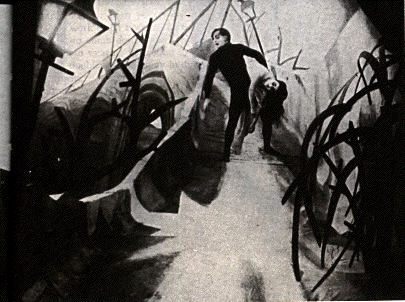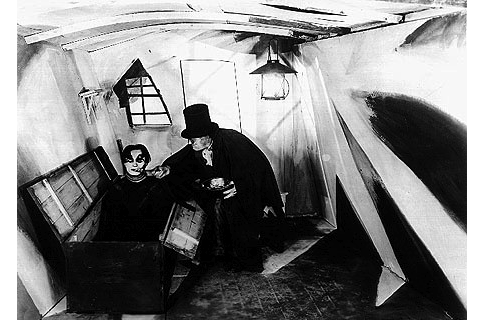Onward to The Cabinet of Dr Caligari, a 1919 German Expressionist film that a lot of people consider to be the first real horror movie. To be fair, it is pretty freaking scary. And it wins a place at #155 on the TSPDT list.
Full Disclosure: I've never seen The Cabinet of Dr Caligari, but I am a really big fan of German Expressionism, so I'm sure that I'll enjoy it.
The film uses a framing device of two men swapping stories on a bench. A haunting woman named Jane glides past them, seemingly unaware of her surroundings. The younger of the two men says that she is his fiancée, and that they have experienced horrors that the other man can only dream of. And he begins to tell their story. I have a feeling that shit will be getting real very shortly.
Francis (the storyteller) agrees to go to a carnival in town with his best friend Alan. Meanwhile, a horrifyingly creepy old man named Dr Caligari (who apparently killed a town clerk to get a permit for the carnival) introduces his sideshow attraction - Cesare, the somnambulist (sleepwalker).
Francis and Alan end up at the show, and when Alan asks the prophetic Cesare how long he has to live, the chilling response is, "Till dawn, tomorrow." Oh yeah...shit is definitely getting real.
They meet up with Jane (now a vibrant young woman) later that night, and it's clear that they've both got a thing for her. Francis suggests that they let her choose who she'd rather be with, but that no matter what happens, they will promise to stay friends. The two shake hands on it, and Alan goes home to bed...where he is violently murdered by a mysterious shadowy figure.
When Francis finds out, he remembers the prophecy and vows to do whatever it takes to solve the crime of his friend's murder. He and a police officer go to search Dr Caligari's home, but are interrupted by the news that a man has just been caught trying to murder an old woman. Obviously, the police assume that he's the man they're been looking for -- only he swears that he had nothing to do with the other two murders.
Dr Caligari has sent Cesare out to kill Jane. He creeps into her bedroom, but at the last moment is captivated by her beauty and decides to kidnap her instead. He is chased by the townspeople to the edge of town, where he discards Jane and promptly dies of exhaustion.
As soon as Jane awakens, she can identify her attacker as Cesare, and the hunt is on for Caligari. Francis tracks him down to a mental institution - and finds out that Caligari is the director there.
Astonished, Francis begins ranting and raving to the psychiatrists. They help him investigate the director, and they find the story of "The Cabinet of Dr Caligari" (apparently a serial killer in the early 1700s) as well as a diary entry celebrating the fact that a sleepwalker has been admitted into the institution. (Not liking where this is headed.) As they read on, they discover his desire to emulate Caligari's work. They bring the dead body of Cesare to the new Caligari, who is driven insane and spends the rest of his days in a padded cell.
No, not really. Because Francis has finished telling his story, and we're back to the two men sitting on the bench. They walk through a courtyard, and it becomes painfully clear that this is a mental institution, full of people in a variety of altered mental states. (Oh God what's going on?) Francis points out one patient as Cesare...and we see "Jane" who is apparently convinced she's a queen. And we slowly begin to realize that Francis is actually quite mad. (I was mistaken before...shit is now officially real.) The director comes out into the courtyard, and Francis becomes enraged, insisting that he's telling the truth. They put him in a straitjacket and take him to his room, but the director assures the other psychiatrists that now that he understands Francis' delusions, he will be able to cure him.
Random Musings:
- So I watched this on Netflix, but when I was looking up background information on IMDB, I found a link to the full version of the film. I clicked on it and immediately noticed the completely different style of the intertitles. I can only assume that one is the American release, and the other is from a European release (obviously not the original German, because well...it's not in German). But look at the difference:
What gives? One set of cards is unique, distinctive, and emulates the style of the film. The other is blah and generic. Why would American distributors purposely use something clearly sub par when there's a lovely alternative available? I must be missing something.
- Oh, I really can't put into words how much I love German expressionism. There are shots in this film that belong in an art museum. Please forgive me while I indulge in a brief lovefest.
Just look at all the odd angles and distorted shapes and general creepiness. It's such a distinctive style of filmmaking and it works so well in the horror genre. I just can't get enough of it.
And I don't care how technologically advanced film gets, it's hard to find a more disturbing, uncomfortable image than this one.
- OK, so the director says at the end that he understands where Francis' delusions were coming from, so now he can be cured? Really? First of all, I'm sure Francis has been telling everyone he meets the story of Dr Caligari, so the director must be slacking on the job if this is the first he's heard of it. Second of all...no. That's not how it works! Just because you know that someone has a delusion, and you know every detail about it, doesn't mean you suddenly know how to fix it. You're stupid, Director. I am more qualified to run a mental institution than you are.
So that's The Cabinet of Dr Caligari. And frankly, it just blew my mind. Not for nothing, but I think this is the earliest film example of a) a framing story and b) a batshit crazy twist ending, that I've seen anyway. It's such an innovative film, and it's so damn creepy. It makes you feel almost uneasy while you're watching it. In terms of acting and directing, it is what it is: an early film before all the kinks had been worked out yet. But still, I think this movie comes off as a lot more advanced and much less presentational than something like Nosferatu, to take an example of a film that has a similar style and is from the same time period. The story is pretty interesting, and dear God that ending. I was not prepared...even though this movie came out nearly 100 years ago and I've obviously heard that it has a twist ending. This is probably one of my favorite of the German expressionist films, it's almost like what it would be like to pop into Edvard Munch's brain for an afternoon! A very good film experience.
Thanks for reading, and come back tomorrow for Gregory's Girl!
Want to know more about the Top 1000 List? Check it out and see if your favorites are here! They Shoot Pictures, Don't They?
Want to know more about the Top 1000 List? Check it out and see if your favorites are here! They Shoot Pictures, Don't They?

















2 comments:
Hey, nice review! I flipped my sh*t for this movie.
In general, silent movies kind of put me to sleep. Hated Nosferatu. But this one? Totally different. Even discounting its unrelenting coolness, it gets points simply for being an influence for Neil Gaiman, who writes some of the weirdest, most destabilizing literature out there.
It struck me that it couldn't have been commonplace to be THAT abstract in your set design back in 1919, when people were just learning how to correctly film what the world actually DID look like. The cinematography is an absolute masterpiece - particularly the part where everyone's chasing Cesare up that zigzaggy, jagged hill.
Incredibly enough to be included as the first chapter in Joe Bob Briggs' book "Profoundly Disturbing: The Shocking Movies That Changed History." There's some pretty elite company in there!
Just now saw your journal, so forgive me if I'm missing that you've already seen these - I generally suck arse at reading my friends page. But if you liked Caligari, you might like M with Peter Lorre, which I've heard is THE first serial killer film, and Metropolis, which you have probably seen if you're a German expressionist fan. Kind of a staple in the genre. But just in case! Highly recommended.
Hey there! Thanks for reading! Yeah, this movie definitely impressed me. The cinematography alone makes it worthy of the Top 1000 list...and then as a cherry on top of the sundae of awesomeness, there's that total WTF twist ending.
I have seen Metropolis in the past, but I'll watching and reviewing both that and M in the near future as part of my attempt to watch all the top 1000 films. So definitely keep an eye out for those! :)
Post a Comment